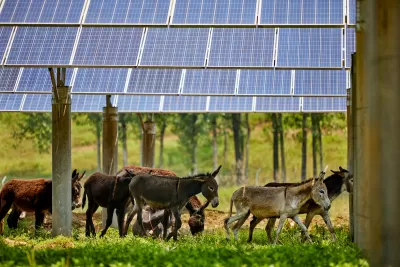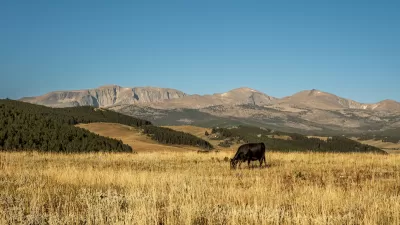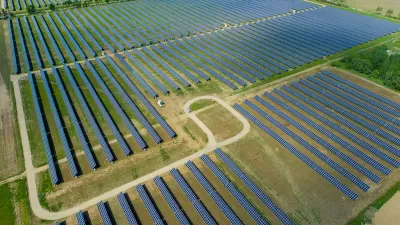How an ‘ecovoltaic’ approach can balance energy production with conservation of sensitive land.

A team of researchers at Colorado State University is looking at ways to lessen the impacts of solar energy production on the environment and reduce conflicts with animal migration, agriculture, ranching, and conservation.
As Matthew Sturchio explains in Honolulu Civil Beat, “A growing alternative to using land solely for solar power generation is called agrivoltaics. As its name suggests, this strategy combines agriculture and solar power on the same piece of land. Agrivoltaic projects can take place on croplands, grazing lands and habitat for agriculturally important pollinators.”
In some of these cases, the shade thrown by solar panels creates micro-environments that benefit different plant communities. “In some cases, mixed conditions like these, with varying levels of light and water, can be a good thing. A well-tested concept in restoration ecology – the science of restoring damaged ecosystems – is that environments with more variety support more diverse mixes of plants and animals.”
Sturchio notes that the location of power transmission lines and ease of access to them also frequently dictate where solar projects can be placed. “New transmission projects that ease this geographic constraint could provide more options. With greater flexibility in choosing sites, developers could shift away from highly sensitive natural ecosystems and install solar arrays on abandoned, water-limited or otherwise degraded lands instead.”
FULL STORY: Solar Power Takes Up A Lot Of Land. Here’s How It Can Be More Ecologically Beneficial

Alabama: Trump Terminates Settlements for Black Communities Harmed By Raw Sewage
Trump deemed the landmark civil rights agreement “illegal DEI and environmental justice policy.”

Planetizen Federal Action Tracker
A weekly monitor of how Trump’s orders and actions are impacting planners and planning in America.

The 120 Year Old Tiny Home Villages That Sheltered San Francisco’s Earthquake Refugees
More than a century ago, San Francisco mobilized to house thousands of residents displaced by the 1906 earthquake. Could their strategy offer a model for the present?

In Both Crashes and Crime, Public Transportation is Far Safer than Driving
Contrary to popular assumptions, public transportation has far lower crash and crime rates than automobile travel. For safer communities, improve and encourage transit travel.

Report: Zoning Reforms Should Complement Nashville’s Ambitious Transit Plan
Without reform, restrictive zoning codes will limit the impact of the city’s planned transit expansion and could exclude some of the residents who depend on transit the most.

Judge Orders Release of Frozen IRA, IIJA Funding
The decision is a victory for environmental groups who charged that freezing funds for critical infrastructure and disaster response programs caused “real and irreparable harm” to communities.
Urban Design for Planners 1: Software Tools
This six-course series explores essential urban design concepts using open source software and equips planners with the tools they need to participate fully in the urban design process.
Planning for Universal Design
Learn the tools for implementing Universal Design in planning regulations.
Clanton & Associates, Inc.
Jessamine County Fiscal Court
Institute for Housing and Urban Development Studies (IHS)
City of Grandview
Harvard GSD Executive Education
Toledo-Lucas County Plan Commissions
Salt Lake City
NYU Wagner Graduate School of Public Service





























